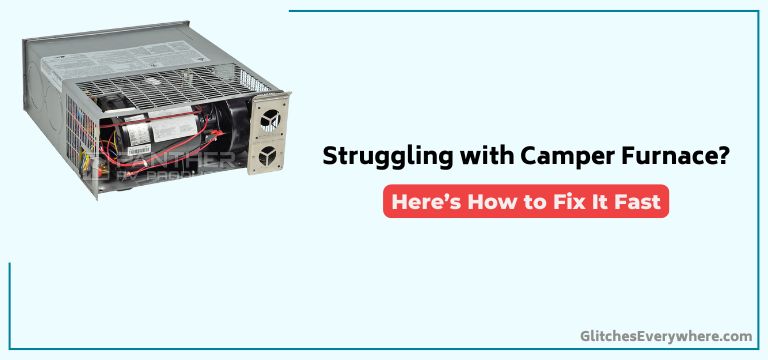The Camper Furnace is a great device, but like all electronics, it sometimes has its issues. If your Camper Furnace is not working, take a look at this troubleshooting guide.
We’ve collected answers to the most frequent reasons you’ll see Camper Furnace not working and explained them in plain language for easy troubleshooting.

Quick Fix
To troubleshoot a camper furnace, check the power supply and thermostat settings, clean the air intake and exhaust vents, inspect the propane supply and connections, and ensure the blower motor and igniter are functioning properly.
Furnace Shuts Off Suddenly
When your camper furnace suddenly shuts off, it can be frustrating and leave you wondering what’s gone wrong.
First, check the furnace’s power supply and guarantee it’s receiving sufficient voltage. If that’s not the issue, inspect the air intake and exhaust vents for blockages or kinks, which can cause the furnace to shut down.
Also, verify that the furnace filter is clean, as a clogged filter can reduce airflow and lead to shutdown. If the furnace is blowing cold air, it may indicate a faulty thermocouple or ignition module.
Finally, consult your owner’s manual or contact a professional if you’re unsure about the issue or how to repair it.
Thermostat Settings and Battery Checks
You’ll want to start by checking your thermostat settings to guarantee it’s set to “Heat” or “Furnace” mode, as incorrect settings can prevent the furnace from turning on.
Next, verify that your 12-volt DC coach battery is fully charged, as a dead battery can prevent the thermostat from operating the furnace.
Thermostat Settings
How do you verify your camper’s thermostat is set correctly?
To guarantee your furnace is functioning properly, you need to check the thermostat settings.
- Check the thermostat’s temperature setting to guarantee it’s set high enough to trigger the furnace.
- Verify the thermostat is set to “heat” mode, not “cool” mode.
- Certify the thermostat isn’t set to “emergency heat” mode, as this can cause the furnace to malfunction.
- Check the thermostat’s battery level, if it’s a wireless or programmable model, to guarantee it’s not causing the issue.
Battery Power Checks
Your camper’s thermostat is set correctly, but the furnace still won’t turn on.
Now, it’s time to check the power source. Guarantee your 12-volt DC coach battery is fully charged, as the thermostat operates on this power.
A dead or weak battery can prevent the furnace from functioning. Verify the battery connections are secure and clean, and check the 12-volt fuse panel to certify the furnace fuse isn’t blown.
If you’re not comfortable with these checks, consider consulting an RV technician. Remember, proper battery power is essential for your thermostat to operate the furnace.
Furnace Installation and Setup Issues
Proper furnace installation is crucial to guarantee the camper’s heating system operates safely and efficiently.
When setting up your furnace, you must certify it’s done correctly to avoid faulty operation or safety hazards.
What you need to check:
- Verify the furnace is level, securely fastened, and all electrical connections are secure and not damaged.
- Check the furnace manual for specific setup requirements.
- Certify the furnace is installed in a well-ventilated area, away from combustible materials, and with adequate clearance from surrounding structures.
- Inspect the furnace’s gas supply line for kinks, blockages, or damage, and certify it’s properly connected to the propane tank and regulator.
Air Filter Inspection and Cleaning
As you troubleshoot your camper’s furnace, you’ll want to inspect and clean the air filter, as a dirty filter can reduce airflow and cause the furnace to malfunction or not ignite at all.
In fact, a dirty air filter can also increase the risk of overheating, leading to a furnace shutdown or even a fire. By verifying your air filter is clean, you’ll help prevent these issues and guarantee your furnace functions properly.
Dirty Filter Causes Issues
One common culprit behind camper furnace troubles is a dirty air filter, which can significantly impede airflow and overall performance.
You’ll want to inspect and clean your filter regularly to prevent these issues. A dirty filter can cause your furnace to work harder, leading to increased energy consumption and potential overheating.
Reduced airflow: A dirty filter restricts airflow, making it harder for your furnace to heat your camper efficiently.
- Reduced airflow: A dirty filter restricts airflow, making it harder for your furnace to heat your camper efficiently.
- Increased energy bills: A dirty filter forces your furnace to work harder, resulting in higher energy consumption and costs.
- Furnace overheating: A dirty filter can cause your furnace to overheat, potentially leading to damage or even failure.
- Premature wear and tear: A dirty filter can reduce the lifespan of your furnace and other camper components.
Clean Filter Ensures Function
Every 1-3 months, depending on your camper usage and environmental conditions, you should inspect and clean your air filter to guarantee peak furnace performance and prevent issues.
A clean air filter certifies your furnace operates efficiently and safely. Failure to do so can lead to reduced airflow, causing your furnace to work harder and potentially overheat or fail.
Additionally, a dirty air filter can lead to increased energy consumption, reduced furnace lifespan, and even safety hazards like carbon monoxide poisoning or fires.
Vent and Duct Blockage Detection
Dust, dirt, and debris accumulating in hidden compartments can silently sabotage your camper’s furnace, leaving you shivering in the cold.
To prevent this, you’ll need to detect and clear any vent and duct blockages.
- The return air compartment, often under the refrigerator or low to the floor, for dust, food, and debris that can block the sail switch from sending a signal to the furnace system to ignite the propane.
- The exterior furnace exhaust vent for spider webs or mud dauber nests that can prevent proper furnace function.
- The foil ductwork for kinks and restrictions that impede airflow, and trim excess ductwork to resolve issues.
- The furnace floor registers to guarantee they’re open, uncovered, and debris-free, preventing back pressure on the system and verifying proper airflow and furnace operation.
Furnace Manual Troubleshooting Guides
Your camper’s furnace manual is a valuable resource when troubleshooting issues, providing model-specific guidance to get your heating system up and running quickly. The manual’s troubleshooting guides are specific to your model and manufacturer, providing step-by-step instructions for common issues like the furnace not turning on or producing heat.
| Trouble | Solution |
|---|---|
| Furnace won’t turn on | Check thermostat settings and battery levels |
| No heat | Inspect air filters and confirm proper installation |
| Error codes | Refer to manual for code explanations and troubleshooting steps |
| Component identification | Use diagrams and illustrations to locate components like sail switch, gas solenoid, and ignition electrode |
Common RV Furnace Error Codes
When you’re troubleshooting your camper’s furnace, error codes can be a valuable starting point.
They can give you a clear indication of what’s going wrong and where to start looking for a solution.
Here are some common RV furnace error codes to watch out for:
- E1: Faulty sail switch or circuit board (Atwood Hydro Flame 8500 IV) – requires replacement by an RV technician.
- F1: Faulty thermostat or temperature sensor (Dometic DFMD30121) – try cleaning or replacing the component.
- Err 3: Propane flow issue (Suburban NT-30SP) – check the propane tank level, regulator, and pigtail hoses for blockages or leaks.
- E5: Faulty control board or ignition module (Coleman Mach 15) – requires replacement by an RV technician.
Advanced Troubleshooting Techniques
Beyond error codes, advanced troubleshooting techniques can help you identify and fix issues with your camper’s furnace.
You’ll need to dig deeper into the system to diagnose problems that aren’t triggered by an error code. Start by checking the circuit board for signs of physical damage, corrosion, or worn-out components.
Use a multimeter to test voltage and resistance in the electrical circuit. If you suspect a faulty thermocouple, try replacing it to see if the furnace kicks in.
You can also try bypassing the thermostat to rule out any issues with the temperature control. By using these advanced techniques, you’ll be able to pinpoint the problem and get your furnace up and running in no time.
Frequently Asked Questions
What Is the Most Common Problem With the RV Furnace?
You’ll often find that the most common issue is an ignition malfunction, preventing the furnace from firing up, or a fuel leak detection problem, which can be hazardous if left unchecked, requiring immediate attention to guarantee safe operation.
Why Is My Furnace Not Kicking on in My Camper?
You’re wondering why your furnace isn’t kicking on, and it’s likely due to a frozen thermostat or faulty igniter. Check your thermostat’s functionality and clean or replace it if necessary, and inspect the igniter for signs of wear or damage.
How Do You Reset the Furnace on a Camper?
When you encounter error codes or furnace lights not illuminating, you’ll need to reset the furnace; turn off the thermostat, locate the small red or black reset button, press it for 3-5 seconds until it clicks, then turn the thermostat back on to test the furnace’s operation.
What Is the Most Common Furnace Failure?
When the warmth of your sanctuary falters, you’ll often find the culprit lurking in the shadows of faulty fuel lines or spark-less ignition systems, as fuel leaks and ignition issues are the most common furnace failures, leaving you shivering in the dark.
Conclusion
You’ve followed the troubleshooting steps, checked the power supply, air intake, and exhaust vents, inspected the circuit board, and even bypassed the thermostat. By methodically ruling out each potential issue, you’ve increased the chances of identifying and resolving the camper furnace problem efficiently. Remember, a thorough and patient approach is key; don’t skip steps, and don’t hesitate to consult the manual or a professional if needed.
Table of Contents

